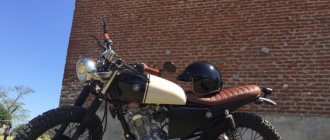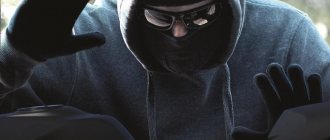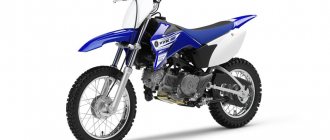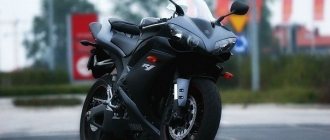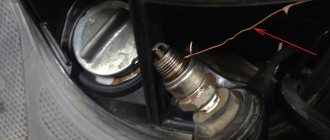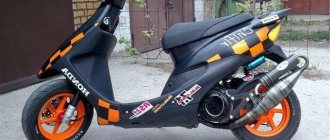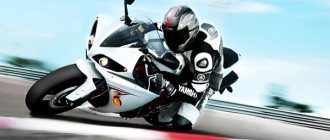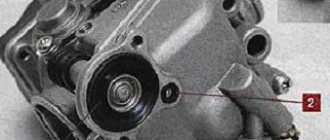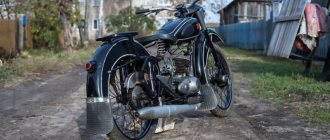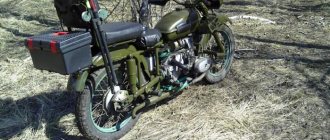What kind of motorcycles does Motobat ride in Moscow?
Looking through numerous reviews of various motorcycles for beginners, most bloggers do not raise the question of the densely populated city in which they will operate this or that motorcycle. When we are talking about some small city with a population of 200 thousand people where the largest highway has two lanes in each direction, it is a completely different matter when we are talking about a 20 million metropolis with huge overpasses, highways and a ring road. highway, the average speed of which is 120 km/h.
The minimum volume of a motorcycle that will be driven around Moscow must be at least 400 cubic meters. see. Anything less will have “crappy” dynamics and, by default, will be driven in the driving lanes in which the largest number of accidents occur.
Do not forget that Moscow is also the most affluent city in the Russian Federation, in which about half of the cars have quite impressive dynamic characteristics and, even though the speed of most roads is limited to 70-80 km/h, owners of expensive foreign cars try to race motorcycles at almost every traffic light , demonstrating the excellent dynamic characteristics of their German cars, while creating emergency situations in which bikers find themselves.
After some time, motorcyclists who started with 400 cubic meters switched to more serious equipment with a volume of 600 and 1000 cubic meters. This type of motorcycle is distinguished by “killer” dynamics and excellent driving characteristics, capable of accelerating the device to 100 km/h in 3-4 seconds.
Naturally, in such conditions, small-sized Chinese motorcycles are not suitable for service in the traffic police, as we see in most regions.
90% of Motobat in Moscow ride police versions of German BMW R1200RT motorcycles of the 1st (2003-2009) and 2nd generation (2008-2014)
You can also find models such as:
BMW G650GS
F800GT
But it is these devices that are found in the smallest quantities, since they do not have such a high safety margin as the R1200RT, the engine of which is designed for 250-300 thousand km.
In fact, it is “Ertech” that serve in the police for more than 10 years and serve, it must be said, faithfully. The cost of such a device on the secondary market today averages 500-700 thousand rubles. Available only in ABS.
Source
Penalties
Untimely registration of motor vehicles (delay of 10 days established by law) leads to a fine of up to 2,000 rubles. The statute of limitations for this violation is 2 months.
For driving an unregistered motorcycle, the driver is punished:
- for a primary violation – a fine of up to 800 rubles;
- for the second time the amount will be 5,000 rubles;
- In case of regular disobedience, the driver may be deprived of his driving license for 4 months.
Registering a motorbike is a standard procedure that guarantees the owner compliance with the law. Registration is not difficult; you just need to spend a little time collecting documents and preparing equipment.
Similar articles
- How quickly do you receive fines from traffic police cameras?
- Step-by-step instructions on how to challenge a traffic police fine with...
- Punishment for violating tinting rules: how to avoid a fine
Motorcycles in the service of traffic police
Since its inception, the motorcycle has become one of the main means of transport not only for civilians, but also for law enforcement agencies. In pre-war times, units of the NKVD of the USSR used PMZ-A-750 motorcycles, produced in the period from 1935 to 1939 at the Podolsk Mechanical Plant in the Moscow region and they can be called the “first police”, as well as those purchased in the late 20s - early 30s -x for traffic control departments (TRAC) and police BMW R11.
After the Great Patriotic War, traffic on the streets began to expand, the number of still luxury cars and much more affordable motorcycles, the movement of which needed to be controlled, increased. Various types of equipment were accepted for service at that time, but still, the main police motorcycle of those years was the M-72, although there were also quite a few IZH-49s.
Until 1953, a police motorcycle could be found in almost any color - uniformity was introduced only by Order of the Ministry of Internal Affairs of December 31, 1953 No. 266 “On the special painting of police cars,” which standardized the color of police cars and motorcycles. It was then that the first color scheme appeared, which included a basic blue color with red stripes. The models of motorcycles in the traffic police service changed at this time, but mostly they were “Urals”. The old ones were in no hurry to be written off, and new models arrived at law enforcement agencies chaotically, and each region remembered its own motorcycles: M-62, M-61, K-750 and other models that served well for decades
In general, Ural motorcycles were the most numerous of all brands produced by the Soviet motorcycle industry and in the service of the State Traffic Inspectorate.
At this time, motorcycles began to be modified specifically for service in the police in general and the traffic police in particular, installing additional equipment (walkie-talkies, SGU, sirens, etc.), as well as changing some parts. For example, some Urals were equipped with generators of increased power. Such motorcycles were assigned additional indices in the model name at the factories. In addition to production motorcycles, prototypes also entered service. The most famous of these was the 1967 Ural M-100 motorcycle with a 1040 cc overhead valve engine and a huge fairing. Unfortunately, the motorcycle, like many other IMZ developments, did not go into mass production, remaining a legend and a collector’s dream along with other prototypes.
In general, traffic police motorcycles were distinguished by higher engine power and installed special equipment. As befits police equipment, they could reach higher speeds than their civilian equivalents. For example, the single model M67P, the production of which began in 1974, accelerated to 125 km/h, and the experienced M-100 easily reached almost the same speed with a side trailer.
Without a stroller, he reached a maximum of 150 km/h. Also among the features of the latter was the use of a hydraulic drive of the brake system, even on the wheel of a side trailer. In the late 60s, the coloring of police motorcycles changed again and became more noticeable. First, in accordance with the industry standard of the USSR Ministry of Internal Affairs, and then in accordance with GOST 21392-75, they received a special color using lemon and blue colors, blue light signals and sound signals with a change in sound frequency. In addition to the inscription “police”, the motorcycles of the State Traffic Inspectorate were marked with the abbreviation “GAI” and the coat of arms of the USSR.
The cars were produced in blue and yellow colors and were specially equipped with a siren, devices for installing traffic police devices, safety bars, and signal lights. In conditions of automobile shortages, motorcycles until the mid-70s made up the majority of the fleet of ORUD and traffic police. And a motorcycle with a sidecar generally became one of the symbols of the State Traffic Inspectorate service of the USSR era. Currently, in many departments, Ural motorcycles are installed on pedestals as a memory of the Soviet period of service.
A new era for the mechanization of traffic police began in the seventies after the introduction of speed limit norms into Soviet traffic regulations. In addition, more and more fast motorcycles began to appear on the roads, which the heavy IMZ could not keep up with even without a sidecar. It is to combat such violators that a special motorized battalion is created in the capital’s traffic police, which later received the name “Motobat” from drivers. At the same time, the Urals continued to be actively used by traffic police officers, but against their background, Motobat employees were equipped with advanced equipment from foreign countries. For them, in 1973-1975, brand new 900 cc BMW R90s were purchased. It was this time that can be considered the beginning of the history of the modern “Motobat”.
In 1990, the coloring of all State Traffic Inspectorate cars changed: instead of yellow, the main color became white, combined with blue elements and inscriptions, and in 1998, the traffic police was renamed the traffic police. At that time, against the backdrop of a deep economic crisis, employees switched to domestic motorcycles, which became the IZH “Jupiter 5” and “Ural”, and later, in the early 2000s, the “Junker”4
Almost all IZHs and Urals in the capital were written off by the end of the 2000s, and until recently these motorcycles could only be found in the regions. All domestic motorcycles that were in the service of the State Traffic Inspectorate became a thing of the past along with the police, becoming part of its history.
Motorized vehicles are currently used in traffic police departments for prompt arrival at the scene of a traffic accident in congestion during rush hour in large cities, for patrolling in the warm season, and also for identifying traffic violations among motorcyclists.
Based on materials from the Research Center for Database, VARIANT LLC, personal photographs of the author.
Source
Documents for registration
To complete the registration procedure, the following documents are required:
- statement;
- receipts for payment of state fees;
- owner's passport;
- motorcycle technical passport (PTS);
- fact of compulsory insurance (MTPL policy in paper or electronic form);
- a document on the basis of which ownership can be established (sale and purchase agreement, store receipt, customs certificate, etc.).
Additionally you may need:
- transit numbers;
- customs documentation if the motorcycle was purchased abroad;
- STS and documents for old numbers, if you plan to keep them;
- certificates from law enforcement agencies if the motorcycle was wanted after the theft.
Police stories. One day in the life of a traffic police inspector during the motorcycle season
Photo: portal Moscow 24/Anton Velikzhanin
What motorcycles do traffic police inspectors use, how the advantages of violators turn into their weaknesses, and why it is easier for a motorcyclist in a dense traffic of highways than on a deserted country road - in the material of a special correspondent of the Moscow 24 portal.
How nice it is to be on the Moscow Ring Road during off-peak hours on a fine spring day! The spring sun plays pleasant reflections on the hood, reflected in the driver’s glasses, the air of your favorite radio station flows from the speakers, and fresh spring air flows from the slightly open windows. The gas pedal goes deeper to the floor and forward, into the endless distance of the asphalt ring and even beyond it! Fortunately, the clearance allows.
Photo: portal Moscow 24/Anton Velikzhanin
I was daydreaming about something and relaxed. And I didn’t notice how another insistent sound was added to the roar of my atmospheric boxer. Like the quack of a goose. But where does he come from here? And then I notice blue and red flashes in the mirrors. Hands instantly squeeze the steering wheel, a hurricane of thoughts rushes through my head: what did I do wrong? Where did he break it? Did you exceed the speed limit and cut someone off while changing lanes? Or maybe the fact is that since the last shoot my photographer has been sitting in the trunk with the fifth door open and clicking the camera shutter with a satisfied look? So he's fastened, it seems.
Photo: portal Moscow 24/Anton Velikzhanin
While in my mind the law-abiding citizen is struggling with the spirit of the rally car, the inspector stands next to the driver's door and waves his hand. Phew, it turns out that this is a colleague of our today's hero. And it shows that we missed a turn and where we can turn around. Well. I'm a disciplined driver, so I obey instructions. I turn onto the exit and, following the patrol motorcycle, dive between the concrete blocks into the traffic police training area.
About preparing for the season
Senior inspector of the 2nd Special Traffic Police Battalion on the special highway of the Main Directorate of the Ministry of Internal Affairs in Moscow, police captain Viktor Kurbatov meets us near his motorcycle. He had just finished discussing the day's program with other officers. And not only his colleagues, but also inspectors from other divisions of the capital’s traffic police gathered here today.
Photo: portal Moscow 24/Anton Velikzhanin
“Now we are conducting emergency training so that those inspectors who serve on motorcycles, as they say, are “rolled into the season.” As you know, some skills are lost if they are not used for a long time. In winter, people don’t press the clutch with their fingers, don’t turn the steering wheel, and if you immediately go out on patrol on a motorcycle, you will feel discomfort. Therefore, these skills need to be restored,” he explains, looking at how the motorcyclists line up in two rows on the site.
Bright red chips are placed everywhere, simulating various obstacles that an inspector may encounter in real city streets. There are large snakes, a circle for turning in a confined space, and figure eights. You need to get used to the “iron horse” gradually, start with simpler elements and gradually move on to complex ones.
Photo: portal Moscow 24/Anton Velikzhanin
In the service of the special traffic police battalion are motorcycles of a German brand, known for its engines for fighter jets, which set speed records at the beginning of the 20th century. Sports-tourism class devices, of course, do not fly, but on the ground they are capable of much. The engine capacity is a respectable 1200 cubic centimeters, the power (to the envy of many budget cars) is 110 horsepower and more than 130 Newton-meters of torque. For a motorcycle, the numbers are scary, but they provide the efficiency patrol officers need.
“The police version of the motorcycle differs from the civilian version in several ways. Firstly, these are other lighting controls: switches for beacons and sirens have been added. Secondly, instead of a radio, there is a second battery, from which the special signals are powered. And thirdly, these are a modified gearbox and shorter gears: due to this, the maximum speed is 20 km/h lower, but the acceleration is much faster,” explains Victor, walking around his vehicle in a circle and pointing to various parts.
Photo: portal Moscow 24/Anton Velikzhanin
An inspector on such an interceptor can reach the first hundred kilometers per hour in a terrifying 3.7 seconds. By the way, a sports car from a famous Japanese brand reaches the same indicator on the speedometer only slightly faster. At the same time, the driver experiences overloads comparable to those felt by a fighter pilot during the Great Patriotic War.
Here I swallow nervously, remembering how it smears across the chair when I give vent to my opposite one. But it’s only a modest 8.5 seconds – that is, twice as long! With such a sharp start on a motorcycle, your arms should probably be torn off! Our hero just smiles and reassures: the numbers are not as scary as they are painted.
Video: portal Moscow 24
The patrolmen also have so-called “geese” - motorcycles of the same concern, nicknamed for their factory index and the characteristic shape of the front fender. This is exactly what greeted us at the entrance to the site. These motorcycles belong to the enduro class, that is, two-wheeled SUVs. They are more maneuverable and are able to overcome almost any obstacle encountered on the inspector’s path: be it a grader, a dirt road soggy from rain, or even a high ladder.
Photo: portal Moscow 24/Anton Velikzhanin
However, the majority of the garage is made up of sports tourists. In terms of their purpose and characteristics, they successfully occupy the “golden mean”: fast enough, passable enough, maneuverable enough and comfortable enough. The boxer engine provides less vibration and a low center of gravity, making it possible to take sharp turns even at walking speed, which is especially important in traffic jams. And the direct landing allows the inspector not to get tired longer. That is, these motorcycles are universal and suitable for performing any task.
About the service
And the tasks are very different. The area of responsibility of the 2nd Specialized Traffic Police Battalion on the special highway is all of Moscow. Inspectors can be sent to patrol any area or highway. And sometimes Captain Viktor Kurbatov and his colleagues accompany convoys taking children on vacation to camps in the Moscow region. It is very difficult to get to know the entire capital, but our hero is trying. He notes that after several years in the battalion, his fellow soldiers know the city better than many local residents.
The police work on a two-by-two schedule, and the morning of a 12-hour shift invariably begins with a divorce and briefing. The inspectors are told the operational situation in the city and key events, after which they are assigned a task for the day. Then the two-wheeled guard goes to the streets of the capital.
Photo: portal Moscow 24/Anton Velikzhanin
“There is an opinion that the motorized battalion was created to exclusively monitor motorcyclists. It is not true. The traffic police inspector performs all his functions regardless of whether he is sitting in a car, on a motorcycle, or even at a stationary post. We also stop crime, pursue violators, register road accidents, issue fines, and, if necessary, assist in apprehending criminals,” says Captain Kurbatov.
And even if a pedestrian crosses the street in the wrong place, an inspector on a motorcycle will slow down next to him. Because the main task of traffic police officers is to ensure road safety. Although, of course, service on a motorcycle has its own specifics.
Photo: portal Moscow 24/Anton Velikzhanin
It's physically harder. Of course, motorcycle inspectors go out on the roads mainly during daylight hours, which is a definite plus. But the roof and air conditioning do not protect them from the vagaries of the weather, and it is hot in a special uniform. Very hot. In addition, driving a motorcycle is more difficult than driving a car. For example, on slippery asphalt after rain, even an experienced motorcyclist can fall. Are there those who have never fallen? And yet, driving along narrow streets with rows of parked cars and on highways in heavy traffic is much easier than driving along a deserted country road, our hero notes.
“I myself am a village guy, I first got on a motorcycle in the village. Mopeds, scooters, motorcycles - such equipment is loved in the outback. I drove through fields and forests and I can say with confidence that driving in the city is easy. But walking along a forest path with slippery roots sticking out of the ground or a kilometer along river sand with a motorcycle swinging from side to side - this gives very good skills. Therefore, those who have had such experience drive more confidently,” he smiles.
Where should the numbers be?
Do you need a front number plate for a motorcycle? There are certain requirements for where exactly the numbers must be located on the motorcycle. These points are specified in the state standard R50577 - 93:
- firstly, only one license plate ;
- second, the sign location is defined as a “vertical, flat, rectangular surface.” It must be selected so that it is not blocked by any of the vehicle structures.
